Terminal care
Friedenheim, also known as the Home of Peace (from the German Frieden - peace - and Heim - home), opened at 133 Mildmay Road, Islington, in November 1885. A meeting had been held the previous year at the home of Dr Alfred T. Schofield to discuss the lack of any special provision for dying men. While hospitals for chronic incurable cases existed, none did so for the dying, who were ineligible for admission to the general hospitals, as they displaced curable cases.
A "small and but little known private home for the dying", Friedenheim had 10 beds and was funded largely at the expense of its instigator, Frances Mary Davidson, a Scottish lady who became its Honorary Superintendent. Intended to provide care for poor people in the last stages of acute disease, such as tuberculosis or cancer, applications for admission soon exceeded accommodation - for each person admitted, some 8 or 9 had to be turned away. The founders planned to purchase a larger suitable property to equip with 50 beds, and began an Appeal to raise £10,000. By 1891 the Home had raised £1,900 and appealed for funds in the British Medical Journal and the British Journal of Nursing. Within the year it had raised £8,000.
In 1892 the Home moved to Sunnyside at 8 Upper Avenue Road (which later became 98 Avenue Road following road renaming and renumbering). The large mansion house, located opposite Swiss Cottage station, stood in 2 acres of grounds. It was adapted for use as a large Home Hospital with 40 beds by a competent hospital engineer. The 2-storey building had six wards (including an Annie Zunz Ward), with utilities in the lower ground floor. There was no Out-Patients Department.
The new Friedenheim was officially opened in November 1892 by the Duchess of Teck. By 1899 the word 'Hospital' had been added to its title (as the word Friedenheim by itself often had to be translated). It had 42 beds, but could have had more had the nursing staff not been accommodated in the building. An appeal was launched to raise £3,000 for a Nurses' Home so that patient accommodation could be increased.
In 1904 a management committee was formed to take over the running of the Hospital from Miss Davidson. Since the Hospital had opened almost 20 years ago, it had admitted some 1,556 patients, of whom 1,066 had died within its walls. Not only English, Scottish and Irish patients had been admitted, but also French, German, Italian, Swiss, Swedish and Armenian.
In 1915, when it had 50 beds, its name was changed to St Columba's Hospital (Home of Peace for the Dying). Terminally ill women were also admitted.
In 1938, some 6,266 patients had been admitted to the Hospital since it opened in 1885, 4,500 of whom had died and 1,737 had been discharged. The average cost of an in-patient per week was £4 16s 5d (£4.82); by 1939 it was £5 8s 2d (£5.41). Patients were expected to contribute towards their keep according to their means, but not less than 2 gns (£2.10) unless in exceptional circumstances.
By the end of the 1930s the Committee decided to look for new premises. A property was offered in Wimbledon but, before it could be bought, war intervened. At the outbreak of war, the Hospital reserved a ward in readiness of war casualties, but was soon allowed by the authorities to use it again for its own patients.
The Hospital joined the NHS in 1948, under the control of the Paddington Group Hospital Management Committee.
By 1954 it had 32 beds.
In 1957 the Hospital moved to The Elms, a large mansion house in Spaniards Road. It had 35 beds.
It closed in 1981.
Present status (March 2008)
The Elms was Grade II listed in 1881. It has been converted into luxury flats.
Sunnyside in Avenue Road was demolished. It became the site of the Hampstead Theatre until its new building nearby opened. The Hospital site is now an open space next to the Swiss Cottage Library.
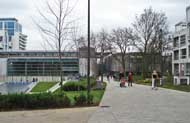
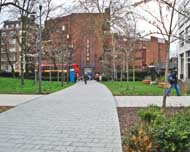
The open space, which was once the second site of the Hospital, as seen from the north (left) and the east (right).
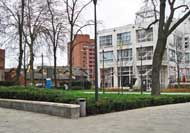
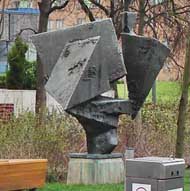
The lawn (left) with a metal sculpture on the site of the old Hampstead Theatre (right).
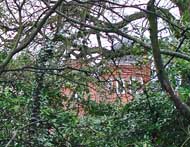
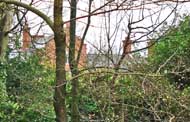
The third and final site of the Hospital, The Elms, is well hidden by trees, which are not necessarily all elms.
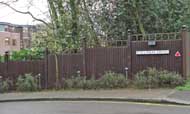
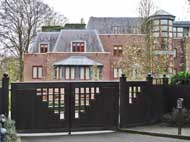
The Elms is accessed by a new road, Columbas Drive, leading to a new gated luxury development.
(Author unstated) 1895 Home of Peace for the Dying. Nursing Record and Hospital World, 25th May, 370.
(Author unstated) 1899 Reflections. British Journal of Nursing, 17th June, 483.
(Author unstated) 1905 Reflections. British Journal of Nursing, 25th March, 235.
Murphy C 1989 From Friedenheim to hospice: a century of cancer hospitals. In: Granshaw L, Porter R (eds) The Hospital in History. London, Routledge, 221-441.
Phayre R, et al. 1891 Home for the dying. British Medical Journal 1 (1589), 1308-1309.
Phayre R, et al. 1891 Home for the dying. British Journal of Nursing, 18th June, 322-323.
Schofield A.T. 1892 A home for the dying. Nursing Record, 27th October, 886-887.
Sprott N.A. 1941 St Columba's Hospital for Advanced Cases. British Medical Journal 2 (4203), 148.
Wade C 1984 The Streets of Hampstead. London, Camden History Society.
www.british-history.ac.uk
www.britishlistedbuildings.co.uk
Return to home page